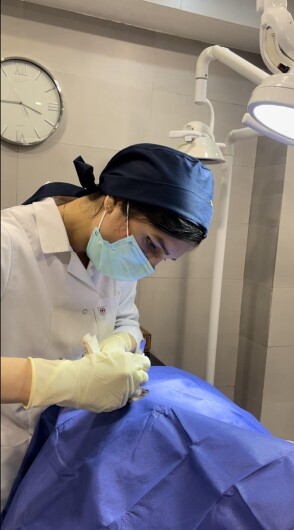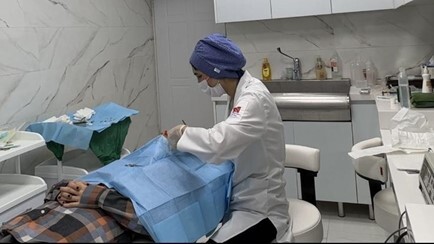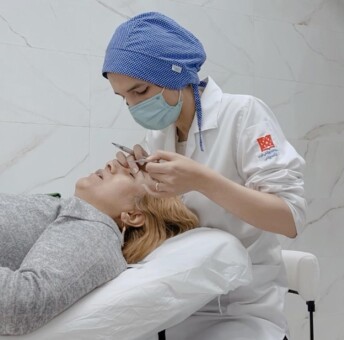Eyelid surgery, or blepharoplasty, is a surgical procedure to improve the appearance of the eyelids.
Surgery can be performed on the upper lids, lower lids or both.
With age, eyelids stretch, and the muscles supporting them weaken. As a result, excess skin and fat can gather above and below your eyelids. This can cause sagging eyebrows, droopy upper lids and bags under the eyes.
Besides aging, severely sagging skin around the eyes can reduce side vision (peripheral vision), especially the upper and outer parts of the visual field. Blepharoplasty can reduce or get rid of these vision problems. The surgery can also make eyes look younger and more alert.
Whether you want to improve your appearance or are experiencing functional problems with your eyelids, eyelid surgery can rejuvenate the area surrounding your eyes.
Risks of blepharoplasty
All surgery has risks, including reaction to anesthesia and blood clots. Besides those, rare risks of eyelid surgery include:
● Infection and bleeding
● Dry, irritated eyes
● Difficulty closing the eyes or other eyelid problems
● Noticeable scarring
● Injury to eye muscles
● Skin discoloration
● Temporarily blurred vision or, rarely, loss of eyesight
● The need for follow-up surgery
What you can expect
● Before the procedure
Blepharoplasty is usually done in an outpatient setting. You might be given drugs such as injections into the eyelids to numb them and drugs through an IV to help you relax.
● During the procedure
For upper eyelids, the surgeon cuts along the fold of the eyelid. The surgeon removes some excess skin, muscle and possibly fat. Then the surgeon closes the cut.
On the lower lid, the surgeon makes a cut just below the lashes in your eye's natural crease or inside the lower lid. The surgeon removes or redistributes excess fat, muscle and sagging skin. Then the surgeon closes the cut.
If your upper eyelid droops close to your pupil, your surgeon may do blepharoplasty combined with a procedure called ptosis (TOE-sis). Ptosis is designed to lift the eyelid as well as remove excess eyelid skin.
● After the procedure
After surgery you spend time in a recovery room where staff members monitor you for complications. You can leave later that day to heal at home.
After surgery you might temporarily have
● Blurred vision from the lubricating ointment applied to your eyes
● Watering eyes
● Light sensitivity
● Double vision
● Puffy, numb eyelids
● Swelling and bruising
● Pain or discomfort
Take the following steps to help you recover from surgery unless your surgeon gives you different instructions.
● Do:
Use ice packs on your eyes for 10 minutes every hour the night after surgery. The following day, use ice packs on your eyes 4 to 5 times throughout the day.
Use prescribed eye drops or ointments.
Sleep with your head raised higher than your chest for a few days.
Apply cool compresses to reduce swelling.
Wear dark sunglasses to protect the skin of your eyelids from sun and wind.
If needed, use acetaminophen to control pain.
● Don't:
Do anything strenuous for a week — no heavy lifting, swimming, jogging or aerobics.
Smoke.
Rub your eyes.
Wear contact lenses for about two weeks.
Take aspirin, ibuprofen (Advil), naproxen sodium , naproxen and other drugs or herbal supplements that can increase bleeding.
As instructed, return to the care provider's office to have stitches removed, if needed.
Seek medical attention immediately if you have any of the following symptoms:
● Shortness of breath
● Chest pain
● An unusual heart rate
● Severe new eye pain
● Bleeding
● Vision problems
Results
Many people who have blepharoplasty say they feel more self-confident and feel they look younger and more rested. For some people, surgery results may last a lifetime. For others, droopy eyelids can recur.
Bruising and swelling generally lessen slowly in about 10-14 days. Scars from the surgical cuts may take months to fade. Take care to protect your delicate eyelid skin from sun exposure.
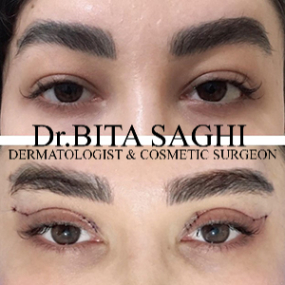
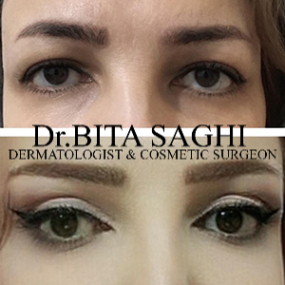
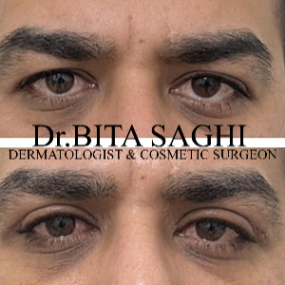
The Saghi Clinic experience
Our patients tell us that the quality of their interactions, our attention to detail and the efficiency of their visits mean health care like they've never experienced.
What eyelid surgery can treat?
● Loose or sagging skin that creates folds or disturbs the natural contour of the upper eyelid, sometimes impairing vision
● Fatty deposits that appear as puffiness in the eyelids
● Bags under the eyes
● Drooping lower eyelids that reveal white below the iris
● Excess skin and fine wrinkles of the lower eyelid
● peripheral vision
Blepharoplasty can be done at the same time as another procedure, such as a brow lift, face-lift or skin resurfacing.
How do you prepare for blepharoplasty?
Before scheduling blepharoplasty, you'll meet with a health care provider. Providers you meet with may include a plastic surgeon, an eye specialist (ophthalmologist), or an dermatologist. The discussion includes:
Your medical history. Your care provider will ask about previous surgeries. Your provider may also ask about past or current conditions such as dry eyes, glaucoma, allergies, circulatory problems, thyroid problems and diabetes. Your provider will also ask about your use of drugs, vitamins, herbal supplements, alcohol, tobacco and illegal drugs.
Your goals. A discussion of what you want from the surgery will help set the stage for a good outcome. Your care provider will discuss with you whether the procedure is likely to work well for you.
Before your eyelid surgery, you'll likely have a physical exam and the following:
Complete eye exam. This might include testing tear production and measuring parts of the eyelids.
Visual field testing. This is to see if there are blind spots in the corners of the eyes (peripheral vision). This is needed to support an insurance claim.
Eyelid photography. Photos from different angles help with planning the surgery, and documenting whether there's a medical reason for it, which might support an insurance claim.
And your provider will likely ask you to do the following:
Stop taking warfarin , aspirin, ibuprofen (Advil, others), naproxen sodium , naproxen , and other drugs or herbal supplements that can increase bleeding. Ask your health care provider how long before surgery to stop taking these drugs. Take only drugs approved by your surgeon.
Quit smoking several weeks before surgery. Smoking can reduce the ability to heal after surgery.
Arrange for someone to drive you to and from surgery if you are having outpatient surgery. Plan to have someone stay with you for the first night after returning home from surgery.
What is the best age to have blepharoplasty?
You can have a blepharoplasty at any time. But if you're seeking one due to aging, you'll usually get the best results about age 35-40. People who are advanced in age should generally avoid the procedure because of the risks of surgical complications
How long does blepharoplasty last?
The results of blepharoplasty (eyelid surgery) are generally long lasting. It's not uncommon for the longevity of results to vary slightly between patients, but you can expect the results of upper eyelid surgery to last about 5 - 7 years, and lower eyelid surgery results are essentially permanent.
Is Blepharoplasty painful?
Generally, an upper lid blepharoplasty is a non painful procedure that patients can usually have performed, and enjoy a minimal amount of post-operative pain medicine, because the procedure is very mild. It's almost like a skin excision, and the eyelid itself is not particularly painful.
Who is not a good candidate for blepharoplasty?
People who are not ideal candidates for eyelid surgery are those who suffer from chronic dry-eye, hypertension, circulation disorders, thyroid disorders, diabetes or heart disease. Individuals who have glaucoma are advised to speak with their doctor before considering the surgery to find out if it is safe for them.
Will I look different after blepharoplasty?
An expertly performed blepharoplasty should look more youthful and awake, but should not change the shape or appearance of your eyes unless that is your aim.
Do Eyebags come back after blepharoplasty?
The results of your blepharoplasty become more visible as side effects, like swelling and bruising, subside. Most patients love their outcomes and do not seek repeat treatments. While future aging may cause your eye bags to return, this ultimately depends on your age, skin condition, and lifestyle choices.
What do eyes look like after blepharoplasty?
After blepharoplasty surgery, the eyelids will be bruised and swollen for 1-3 weeks. However, most patients say their eyes look normal and better than before after 1-3 months. However, people usually feel okay going in public and returning to work after 10-14 days.
What can go wrong with blepharoplasty?
Rare risks of eyelid surgery include: Infection and bleeding. Dry, irritated eyes. Difficulty closing the eyes or other eyelid problems.
Are you awake during blepharoplasty?
In an Awake Blepharoplasty, patients are completely conscious during the procedure. The local anesthesia is usually paired with a soothing sedative to help the patient stay calm and relaxed.
Do eyes look bigger after blepharoplasty?
Yes. Double eyelid surgery (upper and lower blepharoplasty) can make your eyes look bigger by excising excess skin around the eyes and lifting sagging skin
Is blepharoplasty worth getting?
Yes, most patients agree that their upper blepharoplasty was worth the cost and recovery time, and eyelid surgery carries a 95% “Worth It” rating on RealSelf.
Why do my eyes look smaller after blepharoplasty?
Post surgical swelling of the eyelids always cause the eyes to appear more closed in the early post op phase. As the swelling subsides, they return to a more pleasing and youthful appearance.
Will blepharoplasty change my face?
An eyelid surgery, known as a blepharoplasty can also dramatically change your face. It can be performed on the lower and upper eyelid. The procedure can treat a range of facial changes caused by aging.
Will I look younger after blepharoplasty?
By improving the appearance of droopy or sagging skin, your eyes will look younger. In addition to this, your entire face will look more youthful. People who undergo a blepharoplasty enjoy newfound self-confidence in their appearance.
Does blepharoplasty look natural?
While results do vary, you should expect to see brighter, tighter, and more open eyes after cosmetic upper eyelid blepharoplasty. The results can be subtle but impactful. You should look natural, yet more alert and rested, more youthful, and more vibrant.
Do you need someone to stay with you after eyelid surgery?
An adult should stay with you for at least the first 24 hours after surgery. You should rest with your head elevated in a recliner or with at least 2 pillows for the first 48 hours after surgery. Take the prescribed pain medications before you begin to feel discomfort.
What are cons of eyelid surgery?
You may experience side effects: Swelling and bruising are normal and to be expected after surgery. You may also experience dry eyes or irritation. These side effects are typically mild and temporary.
Is blepharoplasty major or minor surgery?
Blepharoplasty is a minimally invasive procedure that dramatically improves appearance and reduces droopy, baggy eyelids.
What happens 2 weeks after blepharoplasty?
1-2 weeks after the eyelid surgery you will still have puffiness and swelling around your eyes. It usually subsides within a period of 2 weeks. The incisions around the eyes will be pinkish-red in colour. Your eyelids will be numb for several days.
Does fat come back after a lower eyelid blepharoplasty?
Yes, it can protrude forward again after a prior blepharoplasty. I generally tell my patients they get 10 or more years of improvement from a lower eyelid "fat" blepharoplasty.
Do eyelashes fall out after blepharoplasty?
Eyelash loss after blepharoplasty is very rare.
Patients will occasionally notice loss of eyelashes after blepharoplasty. As far as I know this is within the normal lifecycle of the hair shaft. The patient's are probably just more aware of the loss because of the recent surgery.
When can I sleep normally after blepharoplasty?
After blepharoplasty, we recommend that you sleep on your back with your head elevated for at least 3-4 weeks. This helps reduce eyelid swelling and speeds up recovery.
How common are blepharoplasty complications?
Complications in blepharoplasty are uncommon and, when they occur, they are usually mild and transient, such as hematomas and chemosis. However, sometimes they can be severe, such as blindness, or they might require surgical correction, such as ectropion.
How do you sleep after blepharoplasty?
Rest and sleep with your head raised on 2 to 3 pillows for 2 weeks or as directed by your surgeon. This will help prevent swelling at your surgical sites. Your eyes may look swollen and bruised after your surgery.
What is the fastest way to recover from a blepharoplasty?
Tips for Rapid Recovery:
● Use an ice pack to reduce swelling. Before your surgery, make sure that you have comfortable ice packs and plenty of gauze on hand for your recovery.
● Wear sunglasses to protect your eyelids.
● Get more sleep.
● Avoid physical exertion.
● Steer clear of smoking and alcohol.
Does skin tighten after blepharoplasty?
An eyelid lift can tighten the skin around the eyes, removing wrinkles or puffiness and giving a person an overall fresher look. An eyelid lift can also be performed for medical reasons.
How many times can you do blepharoplasty?
Upper-eyelid surgery can last anywhere from 5 - 7 years to an entire lifetime, while lower-eyelid surgery rarely needs to be done more than once.
Does blepharoplasty leave a scar?
All blepharoplasty procedures involve incisions into the skin around the eyes. This means that a scar will be left where the incision has been made.
How do I prepare for blepharoplasty?
In preparing for eyelid surgery, you may be asked to:
● Get lab testing or a medical evaluation.
● Take certain medications or adjust your current medications.
● Stop smoking.
● Avoid taking aspirin, anti-inflammatory drugs and herbal supplements as they can increase bleeding and bruising
Can I go walking after a blepharoplasty?
Walking is one of the best form of exercise after eyelid surgery. Walking in the initial phases of recovery can promote blood circulation, prevent blood clots and lead to a smoother recovery. It will give you a surge of energy as well.
Can I work the day after blepharoplasty?
You can generally expect to need between 5-10 days off from work. Usually, people who only get upper or lower blepharoplasty feel up to going back to work after just a week off. Contrastingly, people who get upper and lower eyelid surgery feel they need two full weeks to dedicate to their recovery.
What can you not do after eyelid surgery?
Avoid activities that raise your blood pressure, including bending, lifting and rigorous sports. Keep activities to a minimum for 3-5 days; avoid strenuous activities for 2-3 weeks. Read or watch TV after 2-3 days. Return to work in 10-14 days.
How can I hide my blepharoplasty scars?
After your incisions have healed fully, applying a silicone-based scar cream can improve the appearance of your scars. Your surgeon can advise you on scar creams or tapes to use based on your needs.
How long will my vision be blurry after blepharoplasty?
Your vision may be blurry for some time after surgery. It typically returns to normal after two or three days. Full recovery takes about two to four weeks. During that time, you may have some bruising around your eyes.
What will I look like immediately after blepharoplasty?
Your eyelids will be puffy, your incisions will appear red, and the swelling and bruising may resemble a black eye. This is a hard time for most of our patients because they're anxious to see results. Don't let recovery time get you down. The swelling goes away in about 2 weeks.
How long does a blepharoplasty take to heal?
Once you undergo eyelid surgery, also known as blepharoplasty, you can expect to spend approximately 7-14 days resting and recovering. Once you reach the two-week point, you can enjoy your new, youthful-looking eye area.
Is blepharoplasty painful after?
Generally, an upper lid blepharoplasty is a non painful procedure that patients can usually have performed, and enjoy a minimal amount of post-operative pain medicine, because the procedure is very mild. It's almost like a skin excision, and the eyelid itself is not particularly painful.
Are most people happy with blepharoplasty?
The vast majority of people who have had a blepharoplasty are fully satisfied with their results. Eyelid surgery can make you look years younger after a single procedure, boosting your self-esteem.

